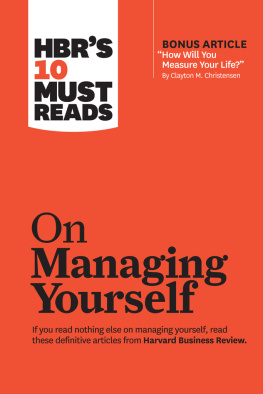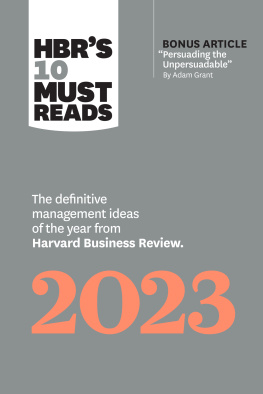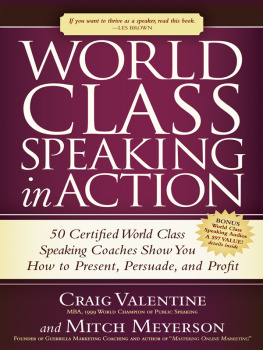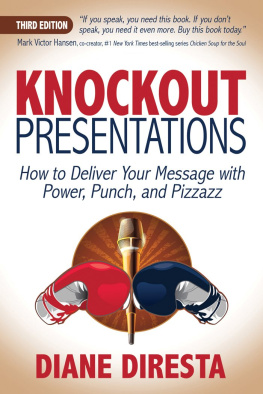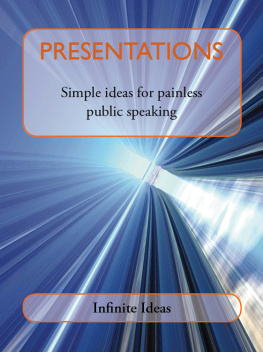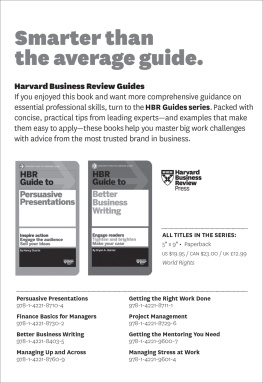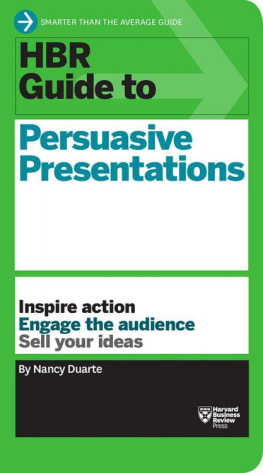Presentations

Get up to speed fast on essential business skills. Whether youre looking for a crash course or a brief refresher, youll find just what you need in HBRs 20-Minute Manager seriesfoundational reading for ambitious professionals and aspiring executives. Each book is a concise, practical primer, so youll have time to brush up on a variety of key management topics.
Advice you can quickly read and apply, from the most trusted source in business.
Titles include:
Creating Business Plans
http://hbr.org/product/creating-business-plans-20-minute-manager-series/an/16998-PBK-ENG
Delegating Work
http://hbr.org/product/delegating-work-20-minute-manager-series/an/16999-PBK-ENG
Finance Basics
http://hbr.org/product/finance-basics-20-minute-manager-series/an/16864-PBK-ENG
Managing Projects
http://hbr.org/product/managing-projects-20-minute-manager-series/an/16862-PBK-ENG
Managing Time
http://hbr.org/product/managing-time-20-minute-manager-series/an/17001-PBK-ENG
Managing Up
http://hbr.org/product/managing-up-20-minute-manager-series/an/16863-PBK-ENG
Presentations
http://hbr.org/product/presentations-20-minute-manager-series/an/16865-PBK-ENG
Running Meetings
http://hbr.org/product/running-meetings-20-minute-manager-series/an/17003-PBK-ENG
Copyright 2014 Harvard Business School Publishing Corporation
All rights reserved
Printed in the United States of America
10 9 8 7 6 5 4 3 2 1
No part of this publication may be reproduced, stored in or introduced into a retrieval system, or transmitted, in any form, or by any means (electronic, mechanical, photocopying, recording, or otherwise), without the prior permission of the publisher. Requests for permission should be directed to permissions@hbsp.harvard.edu, or mailed to Permissions, Harvard Business School Publishing, 60 Harvard Way, Boston, Massachusetts 02163.
The web addresses referenced in this book were live and correct at the time of the books publication but may be subject to change.
Library of Congress Cataloging-in-Publication Data
Presentations.
pages cm
ISBN 978-1-62527-086-3 (alk. paper)
1. Business presentations.
HF5718.22 P74 2014
658.4'52dc23
2013024774
ISBN: 978-1-62527-087-0 (ebook)
Preview
It takes more than personality and PowerPoint to give an effective presentation. But you can learn how, whether youre presenting for the first time or you just need a refresher. This book walks you through the basic steps:
Articulating a clear message.
Tailoring it to your audience.
Organizing your content.
Gathering relevant, persuasive data.
Choosing the right tools and visual aids.
Rehearsing and getting feedback.
Delivering your talk with clarity and confidence.
Fielding questions and following up.
Making improvements for next time.
Contents
Presentations
The Key to Presenting
The Key to Presenting
You have a message to communicate, and youve decided to give a presentation. Youll need to do some work to win people over to your way of thinking. But thats definitely not out of reach, even if you dont consider yourself a naturally gifted public speaker.
No matter what form your presentation takeswhether its a status report, a product demonstration, a sales pitch, or a strategy rolloutthe key to presenting effectively is to know your goals, your audience, and yourself. That core idea informs all the principles in this book.
Lets get right to them.
Why Give a Presentation?
Why Give a Presentation?
If youre planning to present to a business audience, you probably want to inform, persuade, or sell. This may entail:
Explaining new data.
Soliciting ideas or feedback to build consensus.
Asking people to take action.
Seeking help solving a problem.
Getting buy-in on an initiative.
Are you trying to do one of those things or something else? Write down your purpose in a phrase as short as the ones listed above.
Now look at what you wrote and ask whether you even need to give a presentation. Is that the best way to get the job done?
For example, if the number of people you need to reach is quite small, perhaps a quick face-to-face chat with each of them would be more efficient. If the audience is larger but the message is simple and you dont need feedback, an e-mail might suffice.
Sometimes, of course, those forms of communication are inadequate and its clear youll need to give a presentation. If thats the case, youre ready to start working on yours. Hold on to that purpose phrase you wrote down a moment ago; youll need it.
Define Your Goal
Define Your Goal
An effective presentation begins with focused thinking. Youll need to figure out your primary aim, which usually involves getting people to understand something or take action.
Your broad objective
Go back to that short phrase you wrote down earlierturn it into a crisp sentence that states your goal. Begin with I want, and include your audience. Here are some examples:
I want to inform my department about the new process for proposing new product ideas.
I want my colleagues to help brainstorm ideas for the project were about to start.
I want to show people how well my teams new system works.
I want to get other managers to sign on to a set of recommendations Ive developed for our top executives.
I want to give people in my group the tools they need to reach their targets this quarter.
Your broad objective may be nothing like those, but state it just as succinctly. Anyone should be able to understand it without reading it twice.
Your desired outcomes
Now its time to get specific, not about what your presentation will include (that comes later) but about what results you want. Take, for example, this objective from the preceding list:
I want to show people how well my teams new system works.
You dont just want attendees to walk away impressed with the system. You seek outcomes. What are they? Maybe you need people to identify ways they can use the system in their daily work or to take the first step toward implementation within one week. Or maybe youd like them to troubleshoot obstacles and report back to you with their findings within 10 days.
Whatever your desired outcomes, write them down in a list. Theres no magic number, but be realistic; fewer items are usually better. That way, youll tighten your focus and avoid setting your own and your audiences expectations too high.
Your measurement of success
With your broad objective and desired outcomes in hand, identify how you will measure whether youve met your goals.
Do you expect to leave the presentation with ideas that audience members generated? Do you want attendees to complete a set of tasks by a certain deadline? Are you trying to measure soft data, such as enthusiasm and buy-in? How will you gauge those?
Keep the metrics simple and easy to assess, accounting for what your audience can realistically produce. If youre looking for feedback, you might ask people to complete a brief form or online survey. If deliverables are part of the mix, provide a handout that lists those itemssomething physical that audience members can carry away with them and that you can easily send to people who missed the presentation.
Know Your Audience
Know Your Audience
The better you understand your audiences goals and concerns, the more likely you are to achieve your objective and your desired outcomes. And the better able you will be to measure those successes.
Next page



